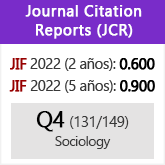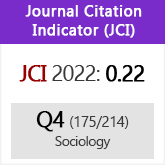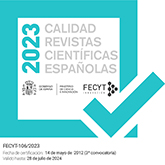Espacios naturales en zonas urbanas. Análisis comparado de la ciudad alemana de Halle y las chilenas de San Pedro de la Paz y Talcahuano
DOI:
https://doi.org/10.3989/ris.2008.05.14Palabras clave:
Ecología Urbana, Naturaleza Urbana, Percepción Social de la naturalezaResumen
Con el objetivo de estudiar la percepción social y la valoración de la naturaleza por personas de diferente estrato social y en ciudades de diferente cultura, se inició un proyecto de cooperación internacional entre Alemania y Chile. Para la realización de este proyecto comparativo se escogieron barrios de clase media-alta y media-baja en cada uno de los países. En Alemania se estudiaron los barrios de Silberhöhe y Paulusviertel de la ciudad de Halle, y en Chile el sector de Tumbes (Comuna de Talcahuano) y la Comuna de San Pedro de la Paz, VIII Región del Biobío. La herramienta base para el estudio fue la aplicación de una encuesta base con las mismas preguntas para cada uno de los países. Se determinó cómo las personas de diferentes procedencias sociales y culturales presentaban un diferente uso y percepción del paisaje urbano. De la misma manera, en Chile la condición social del ciudadano condiciona la posibilidad de acceso a áreas verdes y de recreo.
Descargas
Citas
Akbari, N., S. Davis, S. Dorsano, J. Huang y S. Winnett. eds., 1992. Cooling our Communities: A guidebook on tree planting and light-coloured surfacing. Washington, DC: USEPA.
Anderson, L. M. y H. K. Cordell. 1988. “Influence of Trees on Residential Property Values in Athens, Georgia (USA): A Survey Based on Actual Sales Prices”. Landscape and Urban Planning. 15: 153-164. doi:10.1016/0169-2046(88)90023-0
Austin, M.E. 2004. “Resident Perspectives of the Open Space Conservation Subdivision in Hamburg Township”. Landscape and Urban Planning. 69: 245-253. doi:10.1016/j.landurbplan.2003.09.007
Baker, L., D. Hope, J. Edmonds y L. Lauver. 2001. “Nitrogen Balanced for the Central Arizona-Phoenix (CAP) Ecosystem”. Ecosystem. 4: 582-602. doi:10.1007/s10021-001-0031-2
Beer, A. R. 1994. “Urban Greenspace and Sustainability”. En Sustainable Urban Development: Research and Experiments, H.Van der Vecht et al., pp. 69-88. Holanda: Delft University Press.
Benzeval, M. K. Judge y M. Whitchcad. 1995. Tackling Inequalities in Health. Londres: Kings Fund.
Berman, L. 1997. How does our Garden Grow? A Guide to Community Garden Success. Toronto: FoodShare Metro.
Breuste, J. y S. Wohlleber 1998. “Naturschutz und Landschaftspflege in urbanen Kulturlandschaften Leipzigs“. Zeitschrift fu.r den Erdkundeunterricht. 50: 215-225.
Bruson, L., F. E. Kuo y W.C. Sullivan. 1998a. Sowing the seeds of community: greening and gardening in inner-city neighbourhoods. Unpublished manuscript.
Bruson, L., F. E. Kuo y W.C. Sullivan. 2001. “Resident appropriation of defensible space in urban public housing: Implications for safety and community”. Environment & Behaviour. 335: 626-652. doi:10.1177/00139160121973160
Bussey, S. C. 1996. Public Uses, Preferences and Perceptions of Urban Woodlands in Redditch. Unpublished PhD thesis. University of Central England in Birmingham: UK.
Chenoweth, R. E. y P. H. Gobster. 1990. “The Nature and Ecology of Aesthetic Experiences in the Landscape”. Landscape Journal. 9: 1-18.
Chiesura, A. 2004. “The Role of Urban Parks for the Sustainable City”. Landscape and Urban Planning. 68: 129-138. doi:10.1016/j.landurbplan.2003.08.003
Coles, R.W. y S.C. Bussey. 2000. “Urban Forest Landscapes in the UK, Progressing the Social Agenda”. Landscape & Urban Planning. 52: 181-188. doi:10.1016/S0169-2046(00)00132-8
Douglas, I. 1983. The Urban Environment. Londres: Arnold.
Dwyer, J.F.E.G. McPherson, H. W. Schoeder y R. A. Rowntree. 1992. “Assessing the Benefits and Costs of the Urban Forest”. Journal of Arboriculture. 185: 227-234.
Dwyer, J. F. 1995. The Human Dimensions of Urban Forest Ecosystem Management, in Kollin, C. y M. Barratt, eds., pp. 12-16. Nueva York: Proceedings of the 7th National Urban Forest Conference.
Friedrichs, W. 1992. Methoden der Empirischen Socialforschung. 10 Aufl-Opladen 1982.
Garrido, F. 2000. “La Política Medioambiental de la UE. Sus Orígenes, Evolución e Instrumentos de Aplicación”. En Siglo XXI. Siglo de la Tierra, Navarro, C. coord., pp. 209-245. Córdoba: Instituto de Estudios Transnacionales INET.
Hester, R.T. 1984. Planning Neighbourhood Space with People, ed. Nueva York: Van Nostrand Reinhold.
Hills, J. 1995. Inquiry Into Income and Wealth. vol. 2. Nueva York: Joseph Rowntree Foundation.
Hough, M.1989. City Form and Natural Process. Londres: Routledge.
Inglehart, R. 1991. El cambio cultural en las sociedades industriales avanzadas. Madrid: CIS.
Jacobs, J. 1961. Death and Life of Great American Cities. Toronto: Random House.
Jon, L. 1989. Estructura urbana y diferenciación residencial. El caso de Bilbao. Madrid: CIS.
Kaplan, R. 1993. “Urban Forestry and the Workplace”. En Managing Urban and High use Recreation setting, Gobster, P.H. ed., pp. 41-45. Chicago: USA Forest Service, General Technical Report NC-163.
Kromrey, H. 1991. Empirische Sozialforschung: Modelle und Methoden der Daternerhebung und Datenauswertung.-5. Aufl.- Opladen=UNI-Taschenbücher 1040.
Kuo, F. E., W.C. Sullivan, R. L. Coley y L. Brunson. 1998a. “Fertile Ground for Community: Inner-City Neighbourhood Common Spaces”. American Journal of Community Psychology. 26: 823-851. doi:10.1023/A:1022294028903
Kuo, F. E., M. Bacaicoa y W. C. Sullivan. 1998b. “Transforming Inner City Landscapes: Trees, Sense of Safety, and Preferences”. Environment and Behaviour. 130: 28-59. doi:10.1177/0013916598301002
Kuo, F. E. y W. C. Sullivan. 1999. Do Trees Reduce Crime, Domestic Violence? Unpublished manuscript.
Kuo, F. E. y W. C. Sullivan. 2001. “Environment and Crime in the Inner City: Does Vegetation Reduce Crime?”. Environment and Behaviour. 33: 343-367.
Lewis, C.A. 1992. “Effects of Plants and Gardening in Creating Interpersonal and Community Well-Being”. En The Role of Horticulture in Human Well-Being and Social Development: A National Symposium. Relf, D. ed., pp. 55-65. Portland: Timber Press.
Lewis, C.A. 1996. Green Nature, Human Nature. The Meaning of Plants in Our Lives. Chicago: University of Illinois Press.
MacDonald, L. 1996. “Global Problems, Local Solutions: Measuring the Value of the Urban Forest”. American Forests. 103:26-32.
McDonnell, M.J., S.T.A. Pickett, R.V. Pouyat, W.C. Zipperer, R. W. Parmelee, M. M. Carreiro y K. Medley. 1997. “Ecosystem Processes Along an Urban-to-Rural Gradient”. Urban Ecosystems. 1: 21-36. doi:10.1023/A:1014359024275
McPherson, E.G. 1991. Environmental Benefits and Costs of the Urban Forest. En Robdell, P. D. ed., Proceedings of the Fifth National Urban Forest Conference: Los Ángeles.
McPherson, E. G., D. Nowak, G. Heisler, S. Grimmond, C. Souch, R. Grant y R. Rowntree. 1995. “Results of the Chicago Urban Forest Climate Project”. En Proceedings of the 7th National Urban Forest Conference, Kollin, C. y M. Barratt, eds., Nueva York.
Miles, I. W., C. Sullivan y F. E. Kuo. 1998. “Ecological Restoration Volunteers: The Benefits of Participation.” Urban Ecosystems. 2: 27-41. doi:10.1023/A:1009501515335
Moyano, E. y M. Jiménez-Sánchez. 2005. Los andaluces y el medio ambiente. Ecobarómetro de Andalucía. Sevilla: Consejería de Medio Ambiente, Junta de Andalucía.
Nowak, D. J. K. L. Civerolo, S. T. Rao, S. Sistla, C. J. Luley y D. E. Crane. 2000. “A Modelling Study of the Impact of Urban Trees on Ozone”. Atmospheric Environment. 34: 1601-1613. doi:10.1016/S1352-2310(99)00394-5
Pacione, M. 2003. “Urban Environmental Quality and Human Wellbeing. A Social Geographical Perspective”. Landscape and Urban Planning. 65: 19-30. doi:10.1016/S0169-2046(02)00234-7
Park, R.1915. “The City: Suggestions for the Investigation of Human Behaviour in the city Environment”. American Journal of Sociology. 20: 577-612. doi:10.1086/212433
Peck, S. W. y C. Callaghan. 1999. Greenbacks from Green Roofs: Forging a New Industry in Canada. Ottawa: Canadian Mortgage and Housing Corporation.
Prescott-Allen, R.1991. “Caring for the Earth: A Strategy for Sustainable Living”. IUCN, The World Conservation Union, United Nations Environmental Program, Worldwide Fund for Nature. Gland, Suiza.
Rohde, CLE y A. D. Kendle. 1994. Human Well-being. Natural Landscapes and Wildlife in Urban Areas.A review. English Nature: Peterborough.
Santibáñez, F. y J.M. Uribe. 1993. Atlas Agroclimático de Chile. Regiones Sexta, Séptima, Octava y Novena. Universidad de Chile y Ministerio de Agricultura: Ciudad de Chile.
Sebba, R. 1991. “The Landscape of Childhood: the Reflection Childhood s Environment in Adult Memories and in Children’s Attitudes”. Environment Behavior. 395-422. doi:10.1177/0013916591234001
Selia, A.F. y L. M. Anderson. 1982. “Estimating Costs of Tree Preservation on Residential Lots”. Journal of Arboriculture. 8: 182-185.
Selia, A.F. y L.M. Anderson. 1984. “Estimating Tree Preservation on Urban Residential Lots in Metropolitan Atlanta. Georgia”. Forest Service Research Paper. 48: 6.
Stewart, W. P. D. Liebert y K. W. Larkin. 2004. “Community Identities as Visions for Landscape Change”. Landscape and Urban Planning. 69: 315-334. doi:10.1016/j.landurbplan.2003.07.005
Sukopp, H. y P. Werner. 1983. “Urban Environments and Vegetation”. En Zerbe, S., U. Maurer, S. Schmitz y H. Sukopp. 2003. “Biodiversity in Berlin and its Potential for Nature Conservation”. Landscape and Urban Planning. 62: 139-148.
Tyrvainen, l. y H. Vaananen. 1998. “The Economic Value of Urban Forest Amenities: An Application of the Contingent Valuation Methods”. Urban Planning. 43: 105-118.
Ulrich, R.S. 1976. “Visual Landscape and Psychological Well-being”. Landscape Research. 4: 17-23.
Ulrich, R.S. 1984. “View Through a Window may Influence Recovery from Surgery”. Science. 224: 420-421. doi:10.1126/science.6143402 PMid:6143402
Yearly, S. 1992. The Green Case. A Sociology of Environmental Issues. Arguments and Politics. Londres: Routledge.
Descargas
Publicado
Cómo citar
Número
Sección
Licencia
Derechos de autor 2010 Consejo Superior de Investigaciones Científicas (CSIC)

Esta obra está bajo una licencia internacional Creative Commons Atribución 4.0.
© CSIC. Los originales publicados en las ediciones impresa y electrónica de esta Revista son propiedad del Consejo Superior de Investigaciones Científicas, siendo necesario citar la procedencia en cualquier reproducción parcial o total.Salvo indicación contraria, todos los contenidos de la edición electrónica se distribuyen bajo una licencia de uso y distribución “Creative Commons Reconocimiento 4.0 Internacional ” (CC BY 4.0). Puede consultar desde aquí la versión informativa y el texto legal de la licencia. Esta circunstancia ha de hacerse constar expresamente de esta forma cuando sea necesario.
No se autoriza el depósito en repositorios, páginas web personales o similares de cualquier otra versión distinta a la publicada por el editor.

















